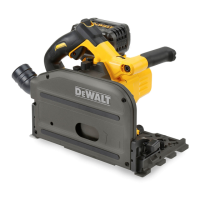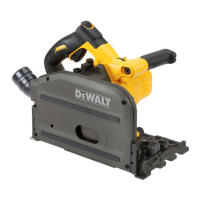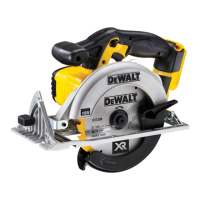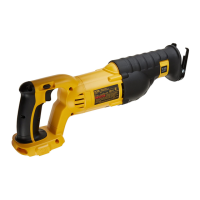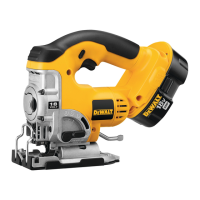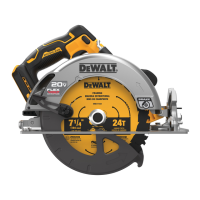20
ENGLISH
Guide Rail System (Fig. M)
DCS579
Guide rails, available in different lengths as accessories, allow
the use of the circular saw for precise, straight clean cuts and
simultaneously protect the workpiece surface against damage.
In conjunction with additional accessories, exact angled cuts,
mitre cuts and fitting work can be completed with the guide
railsystem.
Clamps
37
are available to secure the guide rail
35
to the
workpiece
36
(Fig.M). Use of these clamps
37
ensure that the
guide rail
35
is securely attached to the workpiece
36
for safe
working. Once the guide rail is set to the cut line and securely
fixed to the workpiece, there is no movement duringcutting.
IMPORTANT: The height scale on the unit is set for using the
saw without a guide rail. When using the saw on the guide rail
the difference in height will be approximately 5.0mm.
Setting the Circular Saw To the Guide
Rail(Fig.A,N)
The clearance between the circular saw and the guide rail
(Fig.N,
35
) must be very small to achieve best cutting results.
The smaller this clearance the better the straight line finish will
be on theworkpiece.
The clearance can be set with the two rail adjusters
19
,
20
(Fig.A) for each channel in the base for 0° cutting
19
and for
1–45° bevel cutting
20
. The rail adjusters are precision cams
that allow for the reduction of clearance between the unit
and guide rail. Once these adjusters have been set, sideways
movement of the saw during cutting is kept to a minimum
while allowing a smooth cuttingaction.
NOTE: The adjusters are set to minimum clearance in the
factory and may need adjusting and setting before the unit is
used. Use the following instructions for setting the circular saw
to the guiderail.
REMEMBER: Set the rail adjusters on the saw to the guiderail.
Mounting and Adjusting the Parallel Fence
(Fig. K)
The parallel fence
33
is used for cutting parallel to the edge of
theworkpiece.
Mounting
1. Slacken the parallel fence adjustment knob
32
to allow the
parallel fence topass.
2. Insert the parallel fence
33
in the base plate
11
asshown.
3. Tighten the parallel fence adjustment knob
32
.
Mounting the Dust Extraction Port
(Fig. A, F, L)
Your DCS578/DCS579 circular saws are supplied with a dust
extractionport.
To Install Dust Extraction Port
1. Fully loosen depth adjustment lever
25
.
2. Place base plate
11
in the lowestposition.
3. Align the left half of the dust extraction port
34
over upper
blade guard
15
as shown. Be sure to insert the tab into the
casting notch on the tool. When installed correctly, it will
snap fully over the original depth of cutpointer.
4. Align the right‑hand piece with theleft.
5. Insert screws and tightensecurely.
Adjusting
1. Slacken the fence adjustment knob
32
and set the parallel
fence
33
to the desired width. The adjustment can be read
on the parallel fencescale.
2. Tighten the fence adjustment knob
32
.
Cut Length Indicator (Fig. J)
The markings on the side of the base plate
11
show the length
of the slot being cut into the material at the full depth of the cut.
The markings are in increments of 5mm.
Bevel Detent (Fig. I)
The DCS578 and DCS579 are equipped with a bevel detent
feature. As you tilt the base plate you will hear a click and feel
the base plate stop at both 22.5 and 45degrees. If either of
these is the desired angle, retighten the lever
8
by lowering it.
If you desire another angle, continue tilting the base plate until
the coarse bevel pointer
31
or the fine pointer
30
aligns with
the desiredmark.
Bevel Angle Adjustment (Fig. A, I)
The bevel angle adjustment mechanism
9
can be adjusted
between 0° and 57°.
To achieve better accuracy in cutting, use the fine adjustment
markings located on the pivot bracket
29
.
1. Raise the bevel adjustment lever
8
toloosen.
2. Tilt the base plate to the desired angle by aligning the fine
bevel pointer
30
with the desired angle mark on the pivot
bracket
29
.
3. Lower the bevel adjustment lever toretighten.
4. For the most efficient cutting action using a carbide tipped
saw blade, set the depth adjustment so that about one half
of a tooth projects below the surface of the wood to becut.
5. A method of checking for the correct cutting depth is
shown in Fig.H. Lay a piece of the material you plan to cut
along the side of the blade, as shown in the Figure, and
observe how much tooth projects beyond thematerial.
Adjusting Depth Adjustment Lever (Fig.G)
It may be desirable to adjust the depth adjustment lever
25
. It
may loosen in time and hit the base plate beforetighten ing.
To Tighten the Lever
1. Hold depth adjustment lever
25
and loosen the
locknut
28
.
2. Adjust the depth adjustment lever by rotating it in the
desired direction about 1/8 of arevolution.
3. Retightennut.
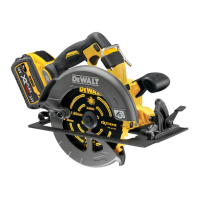
